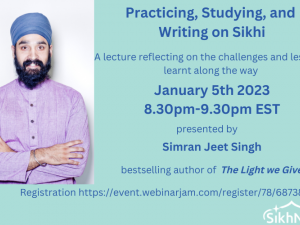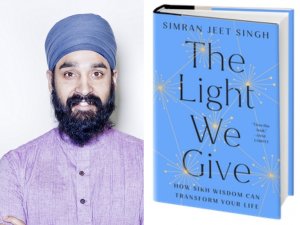Why do we wear turbans?"

08/13/2012: Nearly every Sikh American who grows up in the U.S. asks their families this question and as two Sikh Americans who maintain our faith, we were no different when we were little. This week, as Americans join in vigils for the six murdered Sikhs in another violent act of hate, many are now asking us this same question.
"Our ancestors were beheaded so that we could practice our faith without fear," our grandparents told us, detailing stories of torture and heroism, martyrdom and sacrifice, in 500 years of Sikh history. These stories gave us a legacy that infuses the turban with deep meaning: it embodies our community's commitment to devotion, honor, and service to all, a gift made possible by those who died to protect the practice of our faith.
While some non-Sikhs wear turbans as cultural garb, Sikhs are the only community for whom the turban is religious and nearly every person who wears the turban in the U.S. is Sikh. For many of us, abandoning this visible identity is equivalent to abandoning our faith and core values, including the commitment to protect the right of all people to practice whatever faith they choose.
But in the wake of the shootings of Sikh Americans in Oak Creek, Wisconsin, many Americans may silently wonder: If turbans mark Sikhs as targets for hate and violence, then why not take the turban off? Through a vibrant oral tradition, we Sikhs are emboldened by the stories passed down to us through the generations about why we keep the turban:
During a time of tremendous religious strife, a man named Nanak was born in 15th century Punjab (now Northern India and Pakistan). Guru Nanak expressed a unique vision of unity: Na ko Hindu, Na ko Muslim. There is no Hindu, there is no Muslim - beneath all husks and labels, humanity is one. He carried his message across South and Central Asia, rejecting all social inequalities, including caste hierarchies, gender discrimination, and religious persecution. He called for devotion to the One Divine, justice and equality of all people, and a commitment to seva or divinely-inspired service. And he taught that each person has the potential to develop his or her own relationship with the Divine. His followers were called "Sikhs," or disciples and seekers of truth.
As Guru Nanak passed his leadership on to a succession of teachers, many people embraced the Sikh faith and began wearing turbans to represent their devotion. Through the 16th and 17th centuries, thousands of Sikhs died fighting alongside people of many faiths against political oppression, and the ninth Sikh leader, Guru Tegh Bahadur, was executed by the state for defending the right of all communities to freely practice religion.
"The Guru was beheaded before a big crowd," our grandparents would tell us. "When one brave man brought the Guru's head to his young son, his son asked, 'Were there any Sikhs in the crowd to stand up to this injustice?' The man said he didn't know. The young boy responded, 'From now on, Sikhs will never hide.'" [Emphasis - ED]
As the story goes, the son grew up as the tenth Sikh leader, Guru Gobind Singh. In 1699, he called all Sikhs together and formalized a standard identity. He gave Sikhs five articles of faith, including kesh (uncut hair), meant for women and men equally. Men traditionally wrapped their long hair in turbans. Some women wear turbans too, but most simply cover their heads with headscarves when praying. Guru Gobind Singh requested all Sikhs to drop their surnames (a marker of social status), and instead, embrace a shared surname: all women adopted the last name "Kaur" and men took the last name "Singh." He declared that our eleventh and lasting teacher would be the sacred scriptures - the Guru Granth Sahib. Sikhs pray together in houses of worship and learning called gurdwaras [Doorways to the Divine] to study and sing devotional prayers from scripture.
Through the 18th century, Sikhs were captured, tortured and executed before giving up their turbans or their faith. The Sikh ideal became the warrior-saint: to live a life devoted to God and fiercely committed to fighting injustice in all forms. When India was conquered by the British, Sikhs joined fellow Hindus and Muslims to fight for independence. In recent history, Sikhs have continued to struggle for rights in India, and many Sikhs fled religious persecution in the 1980s to settle in the U.S.
Today, Sikhs belong to the fifth-largest organized religion in the world and are more than half a million strong in the U.S. However, Sikhs continue to encounter racism and religious bigotry since landing on American shores. Early Sikh pioneers, including one of our grandfathers, waited for decades before they were permitted to become citizens or own land. In our own childhoods, we remember racial slurs and shattered windows in the aftermath of the Iran hostage crisis, the first Gulf war, and the Oklahoma City bombing. In the immediate and long-term aftermath of 9/11, Sikhs have been bullied in schools, profiled at airports, barred from workplaces like the military, and targeted in hate violence - including the brutal massacre last Sunday.
In Oak Creek and across the U.S., Sikhs have drawn upon their history of struggle and resilience to rise up in the wake of this tragedy. We witnessed this in person on Thursday morning, when Sikhs were allowed to return to their gurdwara for the first time since the attack. They walked into a crime scene: there was still blood on the carpets and bullet holes in the walls. In an instant, the community burst into action: they ripped out and replaced carpets, scrubbed the floors, painted over bullet holes, and repaired broken windows. We literally watched a community rebuild itself before her eyes.
The Sikh community in Oak Creek reflects the broader Sikh community in America. Some choose to wear only one or two articles of faith; some wear turbans and others don't. Like all faith communities, ours is wonderfully diverse. But all Sikhs, no matter how they practice their faith, share in the spirit of "Chardi Kala" - a rising optimism even in dark times - and are coming together so that good can come from tragedy.
We believe that hate crimes against people who wear turbans, veils, yarmulkes, or robes are attacks on all communities marked as "other" in the American psyche. In a time when the economy is struggling, guns are easily accessible, and ideologues drum up votes through fear-mongering, we must renew our commitment to building safe and caring communities - for Sikhs and for all Americans.
So perhaps by passing along our story to you, it will embolden you the next time you see a turban. Perhaps you will think about the layers of history and resilience wrapped within - and offer a nod of recognition.






